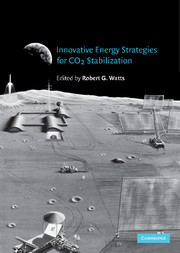Book contents
- Frontmatter
- Contents
- List of contributors
- 1 Concerns about Climate Change and Global Warming
- 2 Posing the Problem
- 3 Adaptive Strategies for Climate Change
- 4 Energy Efficiency: a Little Goes a Long Way
- 5 The Potential of Renewable Energy to Reduce Carbon Emissions
- 6 Carbonless Transportation and Energy Storage in Future Energy Systems
- 7 What Can Nuclear Power Accomplish to Reduce CO2 Emissions
- 8 Nuclear Fusion Energy
- 9 Energy Prosperity Within the Twenty-first Century and Beyond: Options and the Unique Roles of the Sun and the Moon
- 10 Geoengineering the Climate: History and Prospect
- Index
5 - The Potential of Renewable Energy to Reduce Carbon Emissions
Published online by Cambridge University Press: 22 October 2009
- Frontmatter
- Contents
- List of contributors
- 1 Concerns about Climate Change and Global Warming
- 2 Posing the Problem
- 3 Adaptive Strategies for Climate Change
- 4 Energy Efficiency: a Little Goes a Long Way
- 5 The Potential of Renewable Energy to Reduce Carbon Emissions
- 6 Carbonless Transportation and Energy Storage in Future Energy Systems
- 7 What Can Nuclear Power Accomplish to Reduce CO2 Emissions
- 8 Nuclear Fusion Energy
- 9 Energy Prosperity Within the Twenty-first Century and Beyond: Options and the Unique Roles of the Sun and the Moon
- 10 Geoengineering the Climate: History and Prospect
- Index
Summary
Introduction and Overview
Reducing carbon emissions to levels consistent with the stabilization of greenhouse gas concentrations in the atmosphere will require enormous amounts of clean energy supplies to displace current fossil fuel combustion. Renewable energy supplies are one source of such clean energy.
This chapter focuses on terrestrially based renewable energy options. As used here, renewable energy is defined simply as any form of energy that can be used without diminishing the resource. Some forms of renewable energy, like solar and wind, are essentially limitless. Others, like geothermal, may be depleted in the short term, but are eventually regenerated. Some, like hydroelectricity, municipal solid waste, landfill gas, and biomass must be regenerated continually. But none are totally depleted forever.
Renewable energy is generally clean. Most forms of renewable energy do not involve combustion and, therefore, do not emit gases to the atmosphere. In particular, renewables are attractive because they generally emit no net carbon dioxide. What is just as important for those countries experiencing severe local air pollution problems is that non-combusting renewables, like solar and wind, produce energy without emitting sulfur dioxide, nitrogen oxides, particulate matter, or toxic materials. In addition, renewable electric technologies, like photovoltaics and wind that do not use heat to produce electricity, require no water resources for cooling towers, and have no water effluents.
- Type
- Chapter
- Information
- Innovative Energy Strategies for CO2 Stabilization , pp. 123 - 180Publisher: Cambridge University PressPrint publication year: 2002



